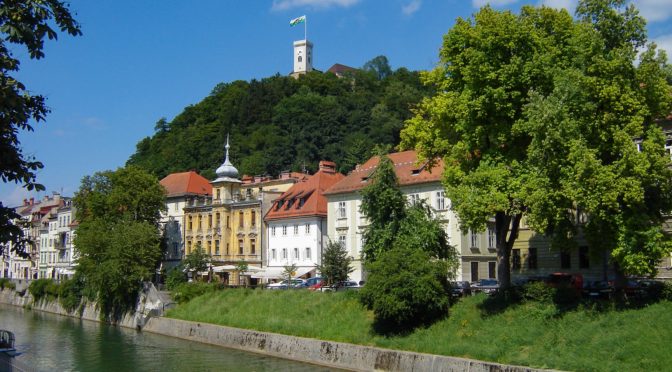Lovely Ljubljana was settled so many thousands of years ago it hurts to think about it. It is home to the world’s oldest axel wooden wheel which is believed to be the first ever created around 3000 years BC.
It also boasts a 43,000-year-old flute and numerous modern-in-contrast Roman artefacts. The city is the nation’s capital but feels more like a very established and prosperous town.

It’s small enough to explore in one day but we enjoyed two days biking and ambling through its streets.
The Roman town of Emona is visible only in a few places, but it was lovely to cycle alongside the still-standing southern walls and track down other sites such as the early Christian burial ground, amphitheatre and the foundations of one surviving mansion.

The medieval quarter, Stari Trg, winds around the slopes below the city’s old castle. It’s home to artisan shops, boutiques and pricey restaurants serving local specialities which we discovered, unfortunately, to include stallion steaks on their menus.
We both drooled over a pair of egg washed wine glasses only to find that they had been hand made in Guatemala! Of course we bought them, as a memory of our back packing adventures through Central America and made sure they survived the trip home buried deeply in Bertha’s bowels.

The public spaces of the modern city were conceived and built during the 1930s by the architect Plecnik, in emulation of Athens.
The result is a very grand and colonnaded centre, with wide boulevards that cross a latticework of bridges which span the fresh green flowing waters of the Ljubljanica river.
Two fierce dragons guard the famous Dragon Bridge, emblems of the city and thought to represent power, greatness and courage.

Heavily glazed and decorated Art Deco buildings variously house coffee shops, department stores and government offices. It’s a beautiful and charming city, cared for and protected by its residents. No surprise to find out Ljubljana means ‘beloved’. It’s well named!
We spent our last day in Slovenia in the hillside thermal town of Lendava, close to the Hungarian border.
In 2011, European Union investment into the town was creating a new community with seemingly outsized cultural and sporting facilities for the modest number of new homes. However, the town’s original socialist spa resort remained atmospherically intact.

We camped in its grounds and enjoyed the swimming, spa and thermal pools of the grimy grey utilitarian buildings.
Our fellow bathers were locals and our Mediterranean tans and English voices caused lots of curious, and sometimes unwelcome, prodding attention.

We gamely bathed in the cloudy green micro-organism filled baths and felt more comfortable joining the children on water slides.
That evening we ventured along the pristine new pavements to stroll uphill into town. We were rewarded by finding a small bar that played our favourite Croatian radio station and sold local wine at less than a €1 a glass.

We toasted Slovenia which we had discovered was forging itself a clean, green, confident future with visible energy for establishing itself as a serious contender on the European stage.
Turning away from the familiarities of western-influenced Europe, we headed off the beaten track into rural Hungary. In 2011, for us (and our Sat Nav) it was the unknown.

